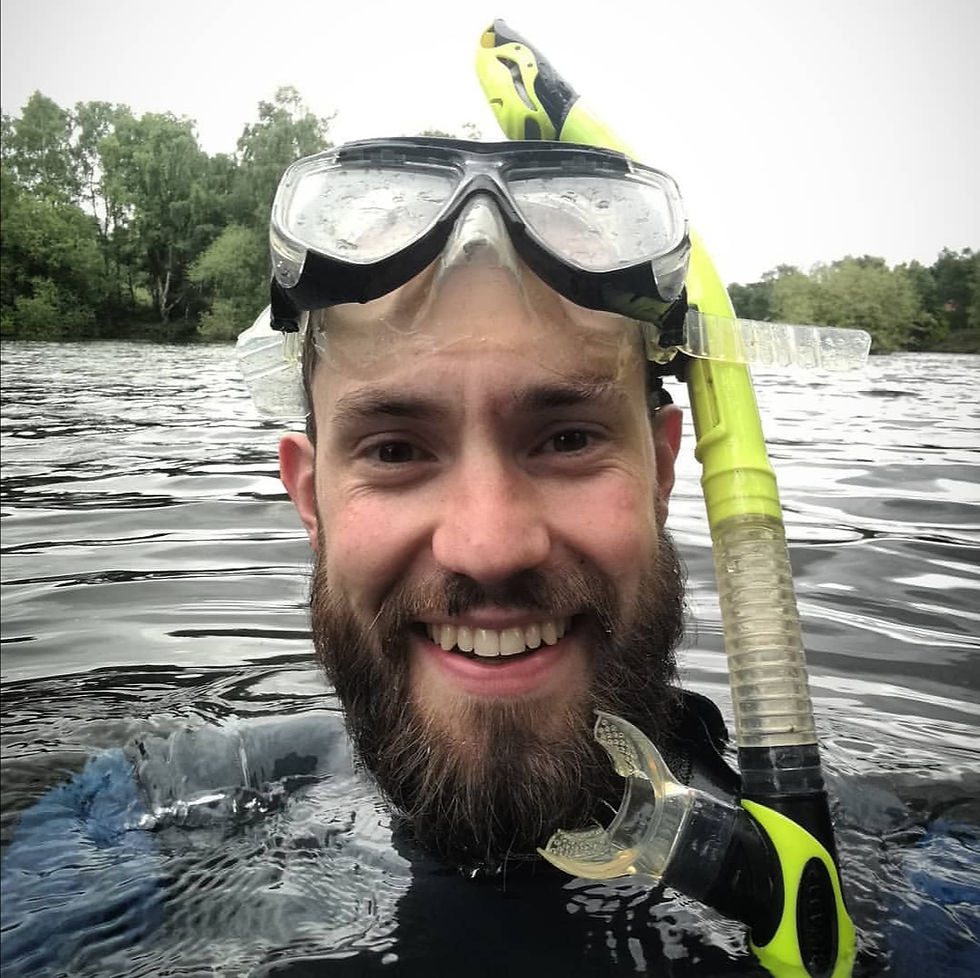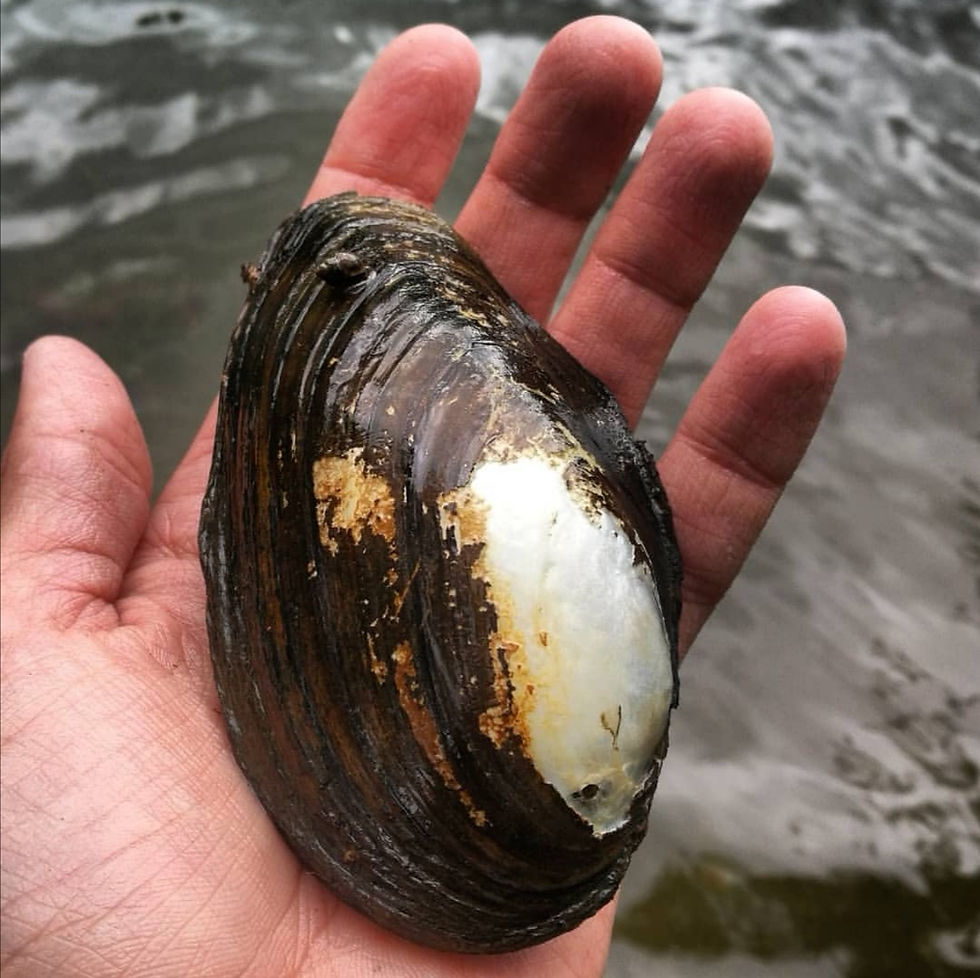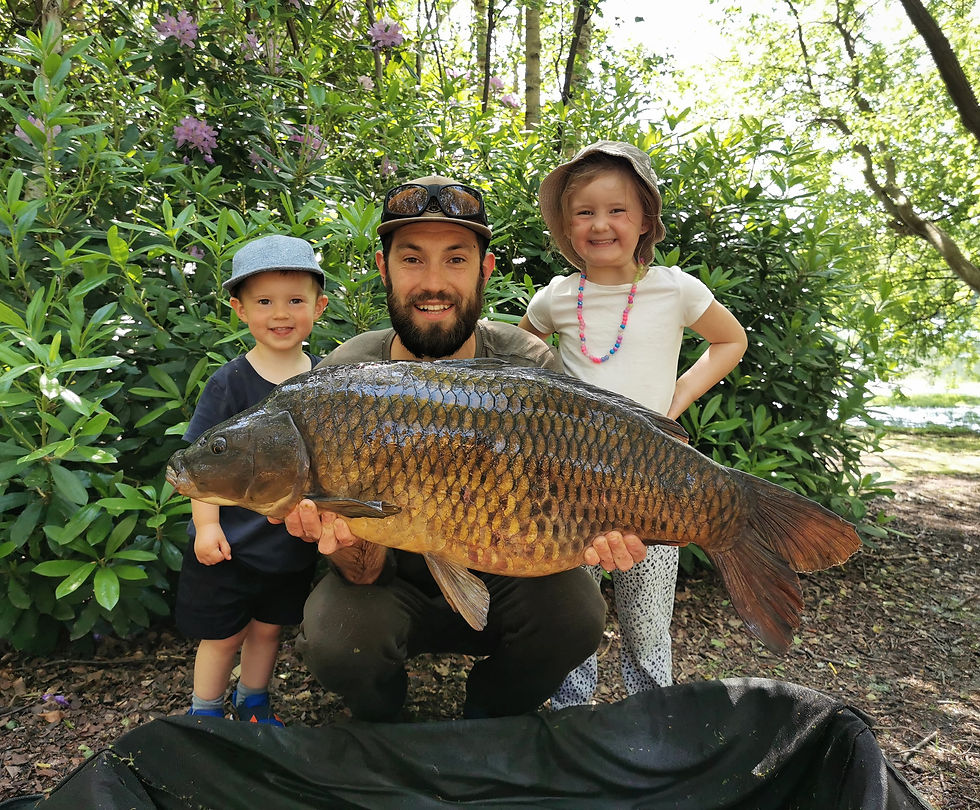Effort = Reward. Gravel pit feature finding
- Lewis Gaukrodger
- Apr 27, 2020
- 7 min read
Updated: May 1, 2020
Firstly before I continue, I am a very competent and confident outdoor swimmer, I have the correct kit to swim in cold water and understand the dangers involved. Please assess your own ability in a safe environment before even considering swimming alone outdoors.

Exploring the topography of an old 1950's Lincolnshire gravel works (now nature reserve and syndicate water) is something I had been thinking about for around a year prior to taking the plunge and booking a day off work.
Slipping into the 5mm wetsuit and donning the fins, whistle and knife; I swam my gear over to an inaccessible bank for security. Armed with my old man's underwater camera I was hoping to get some nice stills of underwater features though no less than 10 minutes in I drown the camera as the battery compartment hadn't been fully compressed and sealed. Nevertheless I continued on my reccy around the margins of the pit.
The first most noticeable feature I came to was a trailer stood on its end in around 13ft of water its top sitting around 2ft under the surface. Thick with a yellowish weed it was very difficult to distinguish it as a trailer, not knowing what maybe further down the trailer I didn't dive to see. Not far off the trailer along the margin line was a discovery that shocked me having spent many an hour in a tree pretty much above the spot but on the edge of the fallen branches from an overhanging bush an almost glowing beacon shone back at me. A series of huge stone blocks caught the sunlight, as big as a small car they stood like the Sarsen stones of Stonehenge. Interestingly there was a 90° shelf cut into one side of a stone and for a second I considered if a rig could be placed there but then I came back to reality and this discovery wiped out any plans of fishing from the tight swim on the bank at the back of the stones.
Moving on past the stones I skulled further around the new bay and had a very similar experience to finding the large stones. With limited visibility to around 3ft as I stared down the deep marginal shelf it was dark in colour however out of nowhere a bright gold colour bounced back through the water column. I instantly thought it was another large stone though his one was deeper than the others at around 6ft. Feeling the bottom with my fins there was no solid stone. In fact what I had found was a perfectly polished 'hand' of sand and gravel that extended off the he steep marginal shelf. Diving on the spot I could see it progressed under the overhanging branches, the bottom was so clean, not a piece of chod on it, the spot was around 4ft in diameter. Whether this was a rubbing spot I am not sure but I was clearly a feature the carp visited.
Standing on the spot with my back to the margin I began to try and fathem out how I could safely drop rigs on the spot. A new swim had been cut out in the new bay during a spring work party but cutting this off was a large willow around 12ft to my right, overhanging and now growing into the pit. The only swim to fish it from was the fallen birch swim and this would require the rods to be positioned in the water, which would pose a challenge as they would also need to be locked down.
However the large willow still posed a problem as I could envisige any hooked fish on a tight line would kite straight into the mass of submerged branches. There was no question the willow had to go. Swimming back over to where I had dumped the kit I dug out the collapsible saw.
Once back at the willow I had no bottom to stand on, I had to fin to tread water and saw the submerged branches from the main trunk. Once free I then proceeded to swim them to the bank to dispose of discreetly. After around an hour I had cleared enough to be happy if a fish was to kite left it wouldn't be in danger of becoming snagged. It hadn't half taken it out of me though, knackered i laid on my back and finned over to my gear and sat and had a warm drink and a light bite to eat, amazed and in awe of what I had found from only a couple of hours.
The next area I wanted to investigate further was the arm or finger bay (this is an area that I thought I knew like the back of my hand as it was the area I had targeted most consistently during my time on the pit). I had barely made it 10 yards into the arm and I found the biggest swan mussel on a dinner plate size of cleared sand.

Not far from this was a feature which made alot of things I had observed fall into place instantly. Across the arm there was a bar coming up to 3ft, it wasn't very wide but this bar would almost act as a cut off for the arm, creating almost a swimming pool in the arm. Therefore when the sun rises and heat penetrates the water- especially in early spring the fish use this area to increase their body temperatures and kick off their metabolisms. It is also the same area the fish spawn religiously. I can't think how many times I have stood and looked at this area of the arm and never seen the bar. Continuing to the middle of the arm I dived on a spot that I had been baiting for a lengthy period of time, however it was no where near as clean as the gravel/sand hand in the new bay which increased my anticipation even more.
Swimming down to the bottom end of the arm I inspected another margin spot (which has produced for me several times) I was amazed to see a 15ft old silver birch trunk laid across it. Lifting the mask up on to my forehand and with a bit of lifting and pivoting I managed to get the trunk out of the swim and clear of the bank. The surface weed was thick at this end of the arm and it made visibility challenging given the amount of light it cut out from reaching the lake bed.
Using the tree lined margin as a reference I swam out of the arm and up towards the islands, it was very evident that the water was much warmer around the islands than that of the deep margin. The back of the islands were most intriguing with massive clumps of dead weed and ditruis, that have the impression they were the bottom until a fin went through it and plumes of chod errupted, swirling with the eddies off the fins. There was an evident shallow plateau at the back of the main island and this areas was the warmest water I had found on the pit, however inaccessible to any cast.
Just past the main island was a visible crater with a scaffolding board laid across it, this was clearly a rubbing hole and justifies the number of shows in this area as the fish charge to the surface from flashing the board and bottom. In close proximity to the flashing hole there is a gravel bar that runs West, I skulled around the back of this bar and found some very clear holes in the weed that could easily be exploted by dropping a rig accurately.
Now close to 4 hours in the pit I was starting to feel the effects of the cold and as soon as this thought crossed the mind it was time to call it a day. But not before a I had gently kicked back to the gear and sorted a bucket of bait to be dropped on the hand of gravel in the new bay.
Over the next 2 weeks I applied bait onto the spot now discreetly marked with 2x 8ft bamboo canes drapped in weed. Diving down to the spot every other night to check if the free offerings had been consumed. On every occasion bar one the spot was clean and had been heavily disturbed with some bait falling down the slope.
With an opportunity mid-week to see if my efforts could be converted to a prize in the sling I got around to the fallen birch swim and set up in the wet suit firstly securing 2 long storm poles in the water to enable me to point the rods directly on the spot. These poles were then lashed together under water with a bungee chord anchoring them to a tree root, achieving a secure and stable position for the rods. To give me further reassurance I looped a length of 30lb braid around the reel seat and pegged this firmly down on the bank. Therefore because I was fishing locked up if the sticks failed the rod would be held firm and not pulled into the pit. With the rigs perfectly hand placed in the middle of the spot, I had dug out my 5oz gripper leads which I usually use on the Tidal Trent. But they served a purpose here to pin everything firm and not allow the rigs to slide down the slope.
With the stove roaring and bats flitting around overhead as the summer night faded away I was hopeful of a pick up.
Hearing a fish crash in the new bay during the dark early hours, I was even more confident. Furthermore as the dawn broke I watched a fish crash directly over the spot bang smack between the 2 bamboo markers. Slipping the waiders on I laid back on the bedchair and watched through the binoculars as several more shows occured in the area.
As expected no more than 30 min after that first crash on the spot the bobbin smashed the underside of the rod and I lept from the bedchair into the pit to snaffle the rod from is positioning. Applying constant pressure I guided the fish away from the tree lined margin and the notorious willow! Feeling the line ping against the tall cabbage stems that grow in that bay she was soon wallowing on the surface as the morning light reflected off her gold leaf flanks, the perfect common. No sooner had she gone in the net I had a quick brew before the gear was packed away and the barrow loaded. Sam nipped around the pit before work to do some photographs for me.



It was very rewarding to land a fish from a spot that I would not have found any other way than to swim in the pit and it's something I will be doing much more in the future to locate wary specimen carp.
What is very apparent though is how much we don't know about areas we think we have a good understanding of and no marker float or bare lead will give you as accurate information as seeing these features with your eyes.




Comments